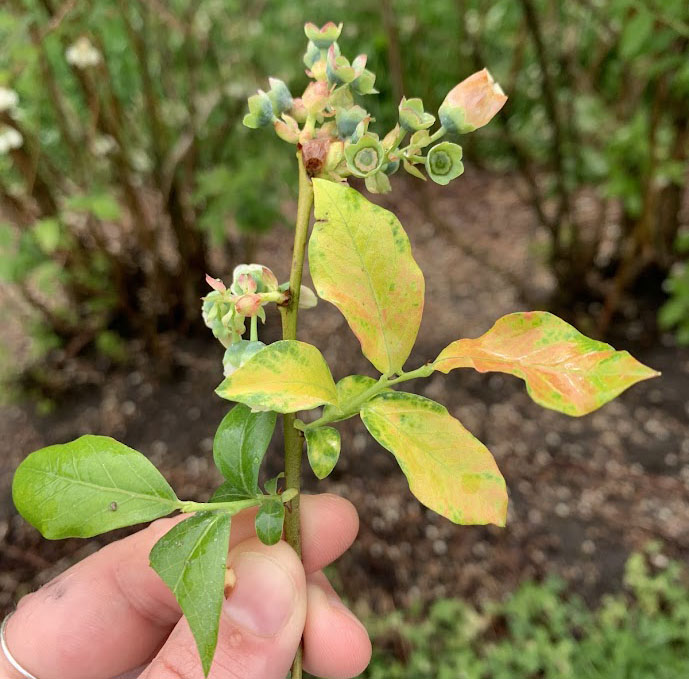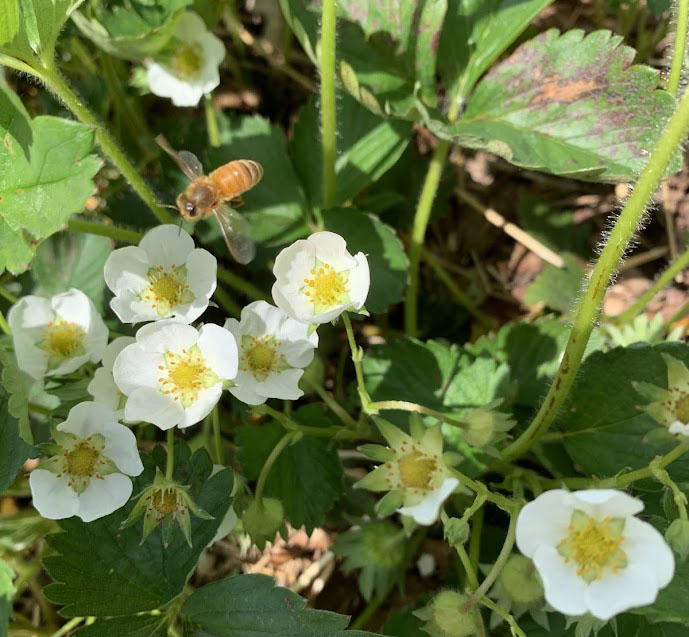Southwest Michigan fruit update – May 14, 2024
Spring is in full swing.

Weather
The past week saw severe storms in parts of the region. This severe weather came through on May 7, and there were four confirmed tornadoes in the Dowagiac and Portage regions. Along with these tornadoes came high winds, large hail and quite a bit of rain. The rest of the week had more typical spring weather with beautiful sunny days interspersed with some rain.
|
Southwest Michigan growing degree day (GDD) summary from March 1 – May 13, 2024 |
|||
|---|---|---|---|
|
Station |
GDD 42 F |
GDD 45 F |
GDD 50 F |
|
Benton Harbor (SWMREC) |
691 |
550 |
359 |
|
Lawton (Lawton) |
684 |
545 |
352 |
|
Fennville (TNRC) |
603 |
470 |
293 |
|
Grand Junction |
677 |
539 |
352 |
|
Average for the SW region |
668 |
530 |
343 |
Watch the latest weather report from Michigan State University meteorologist Jeff Andresen.
Tree fruit
Cold temperatures on April 25 caused damage to fruit buds of plum, cherry and some apple varieties. Catch of San Jose scale adult males was first reported May 6 in Fennville. Females under scales are swelling in advance of releasing crawlers. Crawlers from this generation are expected at 400 to 450 degree-days base 51 degrees Fahrenheit after this biofix. With current temperatures ranging from 50 to 70 F, crawler emergence is approximately 1.5 weeks away. Hot weather will speed this up.
Apricot fruit are up to 1.25 inches in diameter. Plum curculio damage is showing up so protection is needed against this insect pest.
Peach and nectarine are 10 to 14 millimeters (mm) in diameter in central Berrien County. Protection against plum curculio and tarnished plant bug is needed now if the crop warrants the expense. Oriental fruit moth egg hatch is underway—this generation can cause tip dieback of branches if uncontrolled. If peach scab has been a recent problem, one or two sprays can help suppress the buildup on twigs
In cherries, Montmorency tart cherries are 10 to 11 mm and sweets are 14 to 15 mm. More fruit drop is occurring on cherries. Managing cherry leaf spot and plum curculio are the major concerns now. The cherry leaf spot model on Enviroweather indicates five infection periods occurred between April 5 and May 13 this year in central Berrien County compared to one to three infections for the same period for the past four years. In other words, cherry leaf spot pressure could be greater this season.
In plums, Shiro Japanese plum fruit are 18 mm and Stanley European plum are 15 mm in Berrien County. Egglaying scars by plum curculio showed on fruit over the past week in central Berrien County. Protection against this pest and plant bug should be ongoing if the crop load is sufficient to justify the expense. Critical time for fungicide control for black knot is petal fall to late June (10-inch new shoot growth).
Apple fruit range from 12 to 18 mm diameter. Weather conditions have made it difficult to find good windows for applying thinning sprays for fruit. A good summary of thinning tactics from MSU is available. Symptoms from the fire blight infection periods on April 28 and 29 in central Berrien County are predicted to start showing up now, with symptoms expected in about a week from the May 4 and 8 infection periods. Apple scab ascospores are still being caught in significant numbers during rain events—expect to continue control until at least the first week in June. Continued management of powdery mildew and juniper rust is needed for susceptible apple varieties.
First trap catches of codling moth were reported May 6 by the Trevor Nichols Research Center in Fennville. Insecticides such as Rimon targeting egglaying is recommended approximately 100 degree-days base 50 from first catch, which was satisfied on May 14 at the Southwest Michigan Research and Extension Center site in central Berrien County. Insecticides with action against larvae are recommended to start at approximately 200 to 250 degree-days from the May 6 first catch biofix.
Pear (Bartlett) fruit are up to 16 mm in diameter at the Southwest Michigan Research and Extension Center. Maxcel thinning sprays are most effective when used on fruit 6 to 12 mm in diameter and daytime temperatures are expected to be 65 F or higher for two to three days after application. Continued scab sprays are needed to protect green tissue against infection.
Small fruit
In grapes, juice grapes and advanced hybrid wine grapes with good primary shoots have 6-12 inches of growth. Varieties damaged by the April freeze have secondary shoots with a couple inches of growth. Vinifera wine grapes are also around 3-6 inches of growth. With the warm, wet weather we have been experiencing recently and the weather coming up, the focus should be on protecting the developing foliage from phomopsis and early infections of downy and powdery mildew.
Blueberry bloom is wrapping up and small green fruit are developing in some varieties. Growers who still have bloom can apply fungicides to protect open flowers from mummy berry infection. Flowers are most susceptible to both infection and pollination after opening. At the end of bloom, disease control refocuses on both mummy berry infections on late bloom and anthracnose infections to young green fruit. Apply pesticides during bloom in the early morning or at night when bees are unlikely to be foraging. Check out this article about pollinator stewardship during fruit crop bloom.
Want more blueberry specific content? Subscribe to Blueberry Bites!

Strawberry bloom is continuing this week. With bloom and bee activity, do not use insecticides. Cool, wet conditions can favor angular leaf spot, a bacterial disease. The only effective bacterial controls are copper formulations. Growers are looking at early season herbicides to control overwintering weeds and are finishing up spreading straw. When selecting an herbicide, check the pr-harvest interval.

Brambles: Buds have separated from the cane and are starting to open. Some early varieties have expanded leaves. Once you have leaves, you can start scouting for leaf eating insects like sawflies and leafrollers and looking out for diseases like rust.
Upcoming meetings
Our weekly Monday Night South Michigan Fruit IPM Meetings will once again be a hybrid format. The meetings will be held in-person at the Southwest Michigan Research and Extension Center, 1791 Hillandale Rd, Benton Harbor, MI 49022, with virtual attendance available online. Our next meeting is Monday, May 20, at 5:30 p.m. No advanced signup is needed for attending in-person. The meetings are free, and one pesticide applicator credit is available for each meeting.
The MSU Extension blueberry team will be hosting a Blueberry Pollination Meeting on May 15 the Trevor Nichols Research Center in Fennville.
The Unconventional Fruit Working Group 01: Orchard and Vineyard Floor Management will be May 29 from 12:30 - 1:30 p.m. via Zoom. This is a virtual meetup group for fruit farmers who grow fruit using non-conventional practices, including organic farmers. Each 1-hour meeting has a theme, with the first meeting theme being "orchard and vineyard floor management." After a short educational presentation, farmers can share their experiences and listen to the experiences of other farmers. Sign up here. For more information, contact Derek Plotkowski at plotkow5@msu.edu.
Additional information and surveys
Michigan State University is running a pollinator survey this spring and summer to understand how people interact with pollinators in natural, urban and managed landscapes. The survey is anonymous and takes only 10-15 minutes to complete.
This work is supported by the Crop Protection and Pest Management Program [grant no 2021-70006-35450] from the USDA National Institute of Food and Agriculture. Any opinions, findings, conclusions, or recommendations expressed in this publication are those of the author(s) and do not necessarily reflect the view of the U.S. Department of Agriculture.



 Print
Print Email
Email




